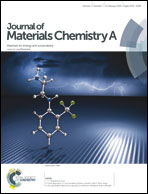Quantitative investigation on the effect of hydrogenation on the performance of MnO2/H-TiO2 composite electrodes for supercapacitors†
Abstract
In this work, high-performance MnO2/H-TiO2/carbon-microfiber nanowire composite electrodes were successfully synthesized. The crystalline properties and electrical conductivity of the H-TiO2 nanowires were studied by X-ray diffraction, Raman scattering and Mott–Schottky theory. To quantitatively investigate the contribution of hydrogenation to the performance of MnO2/H-TiO2 composite electrodes, their electrochemical performance and electrochemical impedance spectroscopy were quantitatively investigated. The physical mechanism is proposed based on the theory of semiconductor physics. Typically, for a composite electrode hydrogenated at 600 °C, the specific capacitance reaches 630.1 F g−1 at 10 mV s−1 and the high energy density of 46.0 W h kg−1 is obtained at the high power density of 21.8 kW kg−1. Moreover, the capacitance retention is 90% after 5000 cycles. This work provides an idea for rationally designing the high-performance supercapacitors and assembling novel nanostructures with preferable electrochemical performance.


 Please wait while we load your content...
Please wait while we load your content...